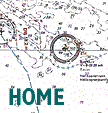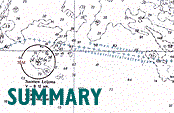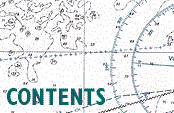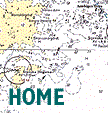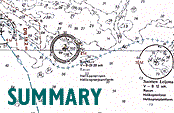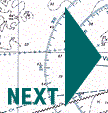CHAPTER 18 COMPLIANCE WITH COLLISION BULKHEAD REQUIREMENTS |
18.1 History of compliance with requirements |
 |
The SOLAS Convention has since its inception contained a requirement for an upper extension of the collision bulkhead in passenger ships with long forward superstructures. The rules of the classification societies did not at the time reflect the SOLAS requirements.
 In the 1981 Amendments to SOLAS 1974 the requirements were extended to apply also to cargo vessels. Previously cargo ro-ro ferries had been developed with a ramp, located far enough forward to reach ashore. This location was generally further forward than that permitted by SOLAS for passenger vessels if the ramp was to form part of the upper extension of the collision bulkhead. In the 1981 Amendments to SOLAS 1974 the requirements were extended to apply also to cargo vessels. Previously cargo ro-ro ferries had been developed with a ramp, located far enough forward to reach ashore. This location was generally further forward than that permitted by SOLAS for passenger vessels if the ramp was to form part of the upper extension of the collision bulkhead.
 In Finland and Sweden the arrangement of the forward ramp in ro-ro passenger ferries seems to have been inherited from the cargo ferries. The Commission has not found any formal document showing approval, exemption or disapproval of any such design under the SOLAS requirements. The first reference that the SOLAS regulations for an upper extension of the collision bulkhead need not be fully applied is a letter of January 1979 concerning two passenger ferries for the Gotland traffic. An exchange of telexes in March 1981 between the ship owner and the Swedish Maritime Administration also exists, where the placing of the KRONPRINSESSAN VICTORIA's ramp too far forward (1800 mm too far forward under SOLAS 1974 and about 500 mm under 1981 draft Amendments) was accepted with a reference to “international and Swedish practice”. No such documentation has been found for the VIKING SALLY/ESTONIA or the DIANA II. A letter dated 20.4.1977 from the Finnish Maritime Administration to the shipyard, however, states that an excessively forward-placed ramp could not be accepted as an upper extension of the collision bulkhead in the TURELLA. Partial collision doors where thus built in e.g. the TURELLA and the ROSELLA (see 18.2). In Finland and Sweden the arrangement of the forward ramp in ro-ro passenger ferries seems to have been inherited from the cargo ferries. The Commission has not found any formal document showing approval, exemption or disapproval of any such design under the SOLAS requirements. The first reference that the SOLAS regulations for an upper extension of the collision bulkhead need not be fully applied is a letter of January 1979 concerning two passenger ferries for the Gotland traffic. An exchange of telexes in March 1981 between the ship owner and the Swedish Maritime Administration also exists, where the placing of the KRONPRINSESSAN VICTORIA's ramp too far forward (1800 mm too far forward under SOLAS 1974 and about 500 mm under 1981 draft Amendments) was accepted with a reference to “international and Swedish practice”. No such documentation has been found for the VIKING SALLY/ESTONIA or the DIANA II. A letter dated 20.4.1977 from the Finnish Maritime Administration to the shipyard, however, states that an excessively forward-placed ramp could not be accepted as an upper extension of the collision bulkhead in the TURELLA. Partial collision doors where thus built in e.g. the TURELLA and the ROSELLA (see 18.2).
 Some of the first passenger ferries built at the beginning of the 1960s with bow visors had an “equivalent” upper extension of the collision bulkhead in the right place but only on the sides, leaving free access to the car deck aft of the bow ramp. The first passenger ferries were used in sheltered waters near land so that the SOLAS regulation on an exemption if the voyage remains within 20 nautical miles of the nearest land may have been in the background when the decisions were made. Some of the first passenger ferries built at the beginning of the 1960s with bow visors had an “equivalent” upper extension of the collision bulkhead in the right place but only on the sides, leaving free access to the car deck aft of the bow ramp. The first passenger ferries were used in sheltered waters near land so that the SOLAS regulation on an exemption if the voyage remains within 20 nautical miles of the nearest land may have been in the background when the decisions were made.
 It thus became common amongst the Finnish and Swedish Maritime Administrations to accept the forward-located bow ramp arrangement. Many ferries built for Baltic ferry operations from 1961 up to about 1985 had a forward-located bow ramp that did not meet the SOLAS requirement for passenger vessels regarding the location of the collision bulkhead upper extension. It thus became common amongst the Finnish and Swedish Maritime Administrations to accept the forward-located bow ramp arrangement. Many ferries built for Baltic ferry operations from 1961 up to about 1985 had a forward-located bow ramp that did not meet the SOLAS requirement for passenger vessels regarding the location of the collision bulkhead upper extension.
 A reason for reluctance to apply the regulations regarding position of the forward ramp fully may have been the IMO work throughout the 1970s on this subject, eventually leading up to the 1981 Amendments. The practical problems in fully applying the SOLAS requirements to ro-ro cargo ferries constituted one of the items considered during this work. The IMO work also resulted in an alternative set of requirements regarding subdivision and stability of passenger ships, in which an upper extension of the collision bulkhead was only required under certain conditions. It may be that the Administrations were awaiting the outcome of this work before they started to change a long-established practice. A reason for reluctance to apply the regulations regarding position of the forward ramp fully may have been the IMO work throughout the 1970s on this subject, eventually leading up to the 1981 Amendments. The practical problems in fully applying the SOLAS requirements to ro-ro cargo ferries constituted one of the items considered during this work. The IMO work also resulted in an alternative set of requirements regarding subdivision and stability of passenger ships, in which an upper extension of the collision bulkhead was only required under certain conditions. It may be that the Administrations were awaiting the outcome of this work before they started to change a long-established practice.
 The 1981 Amendments permitted the upper extension of the collision bulkhead in vessels with a bulbous bow to be positioned further forward than the SOLAS 1974 regulations did. The availability of the text already at the end of the 1970s may at that time have supported the practice of forward-located bow ramps. The 1981 Amendments permitted the upper extension of the collision bulkhead in vessels with a bulbous bow to be positioned further forward than the SOLAS 1974 regulations did. The availability of the text already at the end of the 1970s may at that time have supported the practice of forward-located bow ramps.
 It has thus not been possible to find any formal steps taken in the affected countries regarding approval of the position of the forward ramp in any ship built during the period. There may have been a lenient attitude from the Administrations at the time as they had very limited staffs and relied heavily on the classification societies. These, in turn, did not in most cases have the authorisation to verify compliance with the SOLAS requirements. It has thus not been possible to find any formal steps taken in the affected countries regarding approval of the position of the forward ramp in any ship built during the period. There may have been a lenient attitude from the Administrations at the time as they had very limited staffs and relied heavily on the classification societies. These, in turn, did not in most cases have the authorisation to verify compliance with the SOLAS requirements.
 Only when the 1981 Amendments to SOLAS 1974 came into force on 1 September 1984 specifying in further detail the requirements for the collision bulkhead in passenger ships as well as in cargo ships, did shipyards, administrations and classification societies start to follow the regulations in full. Only when the 1981 Amendments to SOLAS 1974 came into force on 1 September 1984 specifying in further detail the requirements for the collision bulkhead in passenger ships as well as in cargo ships, did shipyards, administrations and classification societies start to follow the regulations in full.
|
 |
18.2 Effects of non-compliance with requirements |
 |
Using the ramp in the ESTONIA as an extended collision bulkhead in compliance with SOLAS 1960 or 1974 would have required a more aft positioning and thus a considerably longer ramp. For housing the longer ramp on the car deck the ramp must have been divided into sections. An alternative would have been to add a second, movable barrier in the proper position and reaching up to deck 4. Both these solutions would have been more expensive and more complicated than the alternative chosen.
 The 1981 Amendments to SOLAS 1974 accepted the ramp as a part of an extended collision bulkhead provided there was a second barrier of a minimum height of 2.3 m in the proper position. This solution was common in ro-ro passenger ferries built for the Finland - Sweden traffic at the same time and subsequent to the ESTONIA, among others the TURELLA and the ROSELLA (see Table 10.2). This solution was also considered in the building specification of the ESTONIA. It was, however, rejected since it was ”for the intended service not required by F.B.N” (Finnish Board of Navigation). The Commission has not found any information on participation of representatives of the Finnish Maritime Administration in formulating this sentence. The 1981 Amendments to SOLAS 1974 accepted the ramp as a part of an extended collision bulkhead provided there was a second barrier of a minimum height of 2.3 m in the proper position. This solution was common in ro-ro passenger ferries built for the Finland - Sweden traffic at the same time and subsequent to the ESTONIA, among others the TURELLA and the ROSELLA (see Table 10.2). This solution was also considered in the building specification of the ESTONIA. It was, however, rejected since it was ”for the intended service not required by F.B.N” (Finnish Board of Navigation). The Commission has not found any information on participation of representatives of the Finnish Maritime Administration in formulating this sentence.
 It is the opinion of the Commission that an extended collision bulkhead, built in compliance with either SOLAS 1974 or the 1981 Amendments, would have increased the Estonia's chances of surviving the loss of the visor. The 2.3-m- high barriers built in the TURELLA and the ROSELLA in 1979 and 1980, respectively, had however a rather low design load of about 2 m static water head and were not designed to withstand hydrodynamic impact loads which may arise if the ramp is fully open in heavy head or bow seas. It is the opinion of the Commission that an extended collision bulkhead, built in compliance with either SOLAS 1974 or the 1981 Amendments, would have increased the Estonia's chances of surviving the loss of the visor. The 2.3-m- high barriers built in the TURELLA and the ROSELLA in 1979 and 1980, respectively, had however a rather low design load of about 2 m static water head and were not designed to withstand hydrodynamic impact loads which may arise if the ramp is fully open in heavy head or bow seas.
|
 |
18.3 The role of the administration |
 |
The Finnish Maritime Administration was, according to a national decree, originally issued in 1920 (3.6.4), exempted from carrying out a hull survey as part of the basis for issuing the passenger ship safety certificate, if a vessel had a valid class certificate. The Administration did not therefore survey the hull construction during the building of the ESTONIA.
 The Bureau Veritas regulations for the initial hull survey included compliance with all applicable requirements specified in the rules of the society and valid at the time. These rules did not include requirements for an upper extension of the collision bulkhead, and hence no reference to the position of such an extension. The Bureau Veritas regulations for the initial hull survey included compliance with all applicable requirements specified in the rules of the society and valid at the time. These rules did not include requirements for an upper extension of the collision bulkhead, and hence no reference to the position of such an extension.
 According to the Finnish Administration, the problem concerning the deviation of the ramp location from the SOLAS requirement for an upper extension of the collision bulkhead was not known to its inspectors. Anyhow, according to the same information, the Administration would have accepted the deviation in line with previous practice, applied also by the Swedish Maritime Administration. According to the Finnish Administration, the problem concerning the deviation of the ramp location from the SOLAS requirement for an upper extension of the collision bulkhead was not known to its inspectors. Anyhow, according to the same information, the Administration would have accepted the deviation in line with previous practice, applied also by the Swedish Maritime Administration.
 The Commission has noted that full responsibility for enforcing compliance with the Conventions nevertheless, according to SOLAS, remains with the Administration. The Commission has also noted that the unrestricted right of the Finnish Maritime Administration to rely on classification society hull surveys in this respect was withdrawn in the new decree on surveys of ships issued in 1983. The Commission has noted that full responsibility for enforcing compliance with the Conventions nevertheless, according to SOLAS, remains with the Administration. The Commission has also noted that the unrestricted right of the Finnish Maritime Administration to rely on classification society hull surveys in this respect was withdrawn in the new decree on surveys of ships issued in 1983.
 It seems obvious to the Commission that the interpretation of the SOLAS Convention's collision bulkhead regulations common at the time did not ensure satisfactory compliance with applicable rules and made it possible to design the ESTONIA in a way which may have contributed to her capsizal. The Commission finds it unacceptable that practice is developed that makes it possible to deviate from a Convention with no documentation or exemptions in the certificate. It seems obvious to the Commission that the interpretation of the SOLAS Convention's collision bulkhead regulations common at the time did not ensure satisfactory compliance with applicable rules and made it possible to design the ESTONIA in a way which may have contributed to her capsizal. The Commission finds it unacceptable that practice is developed that makes it possible to deviate from a Convention with no documentation or exemptions in the certificate.
 |
 |

